Modern Stonemasonry
Contents |
[edit] CNC engineering and water jet cutting
The craft of stonemasonry has been around for millennia and natural stone is still quarried and fashioned into blocks or slabs in much the same sequence of events as before.
What has changed dramatically is the machinery used to fashion the stone. Hand skills such as polishing and carving are still used to finish the work where appropriate but now the bulk of the process is accomplished by machine.
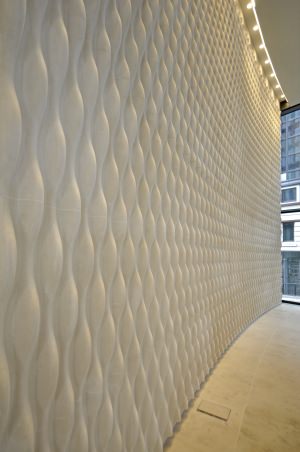
Machined Portland Stone feature wall at Two New Ludgate
[edit] 3D rendering
Architectural models or scans of existing objects can be used to generate surface files that are then sent to a CNC-equipped cutting machine, such as the 5-axis machine installed by stoneCIRCLE which can be used to rough out and saw blocks, as well as shape, contour, engrave and polish them. This is very useful for the production of large monuments or replicating architectural details for restoration projects. The articles can then be finished by hand if necessary.

A 3D rendering of a column capital used to generate surface files
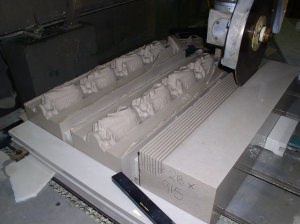
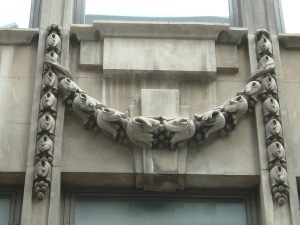
Machining Portland Stone swags for a restoration project and the finished swags in situ at 159 Fenchurch Street.
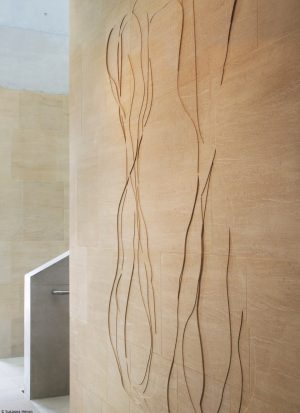
Susanna Heron's Jaumont Yellow Limestone frieze, Henslow's Walk
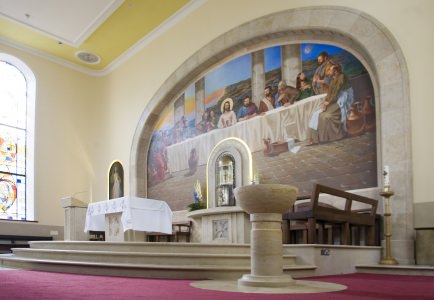
The limestone arch, altar, lectern, font and tabernacle were all produced using CNC-equipped cutting machines.
[edit] Water-jet cutting
Water-jet cutting allows intricate patterns to be cut into stone to create inlaid work for surfaces such as walls and floors and for pierced lattices and grills. It can also be used more creatively as is shown in artworks by Rhona Smith and Julian Opie where bronze is cut on the waterjet cutting machine before being patinated and then inserted into routed Portland Stone.
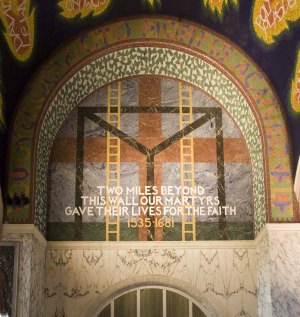
Tom Phillip's depiction of Tyburn Gallows in Westminster Cathedral is an example of waterjet cutting using several different marbles.
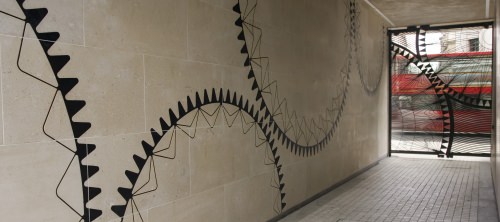
An Age, An Instant by Rhona Smith features waterjet cut bronze set in Portland Stone
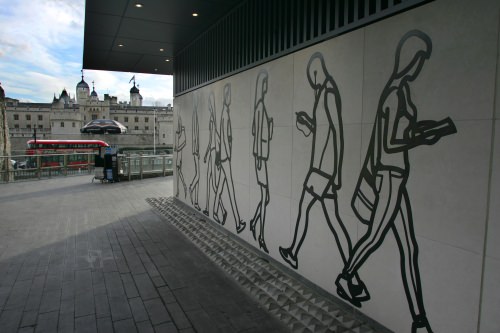
Julian Opie's art installations for CitizenM Hotel, Tower of London and the Hamilton Princess Bermuda use the same technique.

This intricate floor was produced using marble cut on the waterjet cutter and then inlaid into a Nero Marquina marble base.
[edit] Stone: still relevant
As the case studies above show, natural stone is still a relevant material that can be used to create award-winning new architecture. The use of modern technology renders the process much less expensive and time-consuming than it once was and this is made easier still by the use of a stonemason based in the UK with all the advantages of language and proximity that that conveys.
--Stonecircle 11:36, 11 Sep 2018 (BST)
[edit] Related articles on Designing Buildings Wiki
- Building with structural stone.
- Types of stone.
- Choosing stone.
- Kentish ragstone.
- Limestone for building.
- Masonry.
- Iraq, Afghanistan, Gulf War Memorial
- Julian Opie Art Wall CitizenM Tower of London Hotel
- Two New Ludgate Portland Stone Feature Wall
- Use of Stone in Monks Lantern Weybridge
- Bookmatched Marble for Boutique Hotel
- Portland Stone.
- Sustainable stone.
- Julian Opie Limestone & Bronze Frieze for Bermuda Hotel
- Voussoir.
Featured articles and news
The UK's Modern Industrial Strategy: A 10 year plan
Previous consultation criticism, current key elements and general support with some persisting reservations.
Building Safety Regulator reforms
New roles, new staff and a new fast track service pave the way for a single construction regulator.
Architectural Technologist CPDs and Communications
CIAT CPD… and how you can do it!
Cooling centres and cool spaces
Managing extreme heat in cities by directing the public to places for heat stress relief and water sources.
Winter gardens: A brief history and warm variations
Extending the season with glass in different forms and terms.
Restoring Great Yarmouth's Winter Gardens
Transforming one of the least sustainable constructions imaginable.
Construction Skills Mission Board launch sector drive
Newly formed government and industry collaboration set strategy for recruiting an additional 100,000 construction workers a year.
New Architects Code comes into effect in September 2025
ARB Architects Code of Conduct and Practice available with ongoing consultation regarding guidance.
Welsh Skills Body (Medr) launches ambitious plan
The new skills body brings together funding and regulation of tertiary education and research for the devolved nation.
Paul Gandy FCIOB announced as next CIOB President
Former Tilbury Douglas CEO takes helm.
UK Infrastructure: A 10 Year Strategy. In brief with reactions
With the National Infrastructure and Service Transformation Authority (NISTA).
Ebenezer Howard: inventor of the garden city. Book review.
The Grenfell Tower fire, eight years on
A time to pause and reflect as Dubai tower block fire reported just before anniversary.
Airtightness Topic Guide BSRIA TG 27/2025
Explaining the basics of airtightness, what it is, why it's important, when it's required and how it's carried out.
Construction contract awards hit lowest point of 2025
Plummeting for second consecutive month, intensifying concerns for housing and infrastructure goals.
Understanding Mental Health in the Built Environment 2025
Examining the state of mental health in construction, shedding light on levels of stress, anxiety and depression.





















